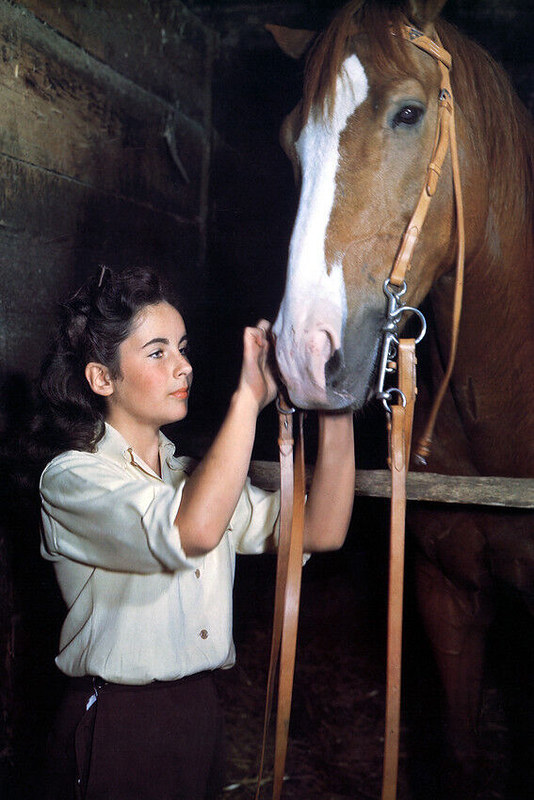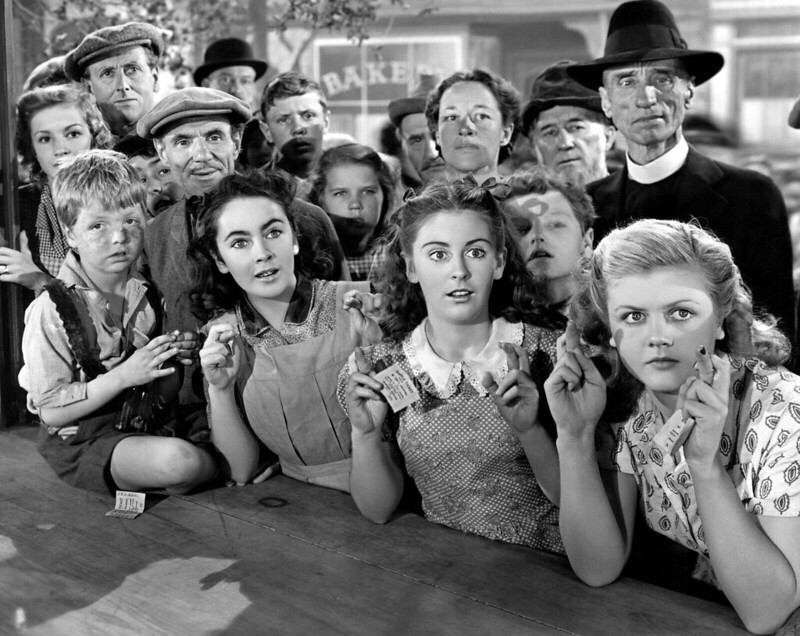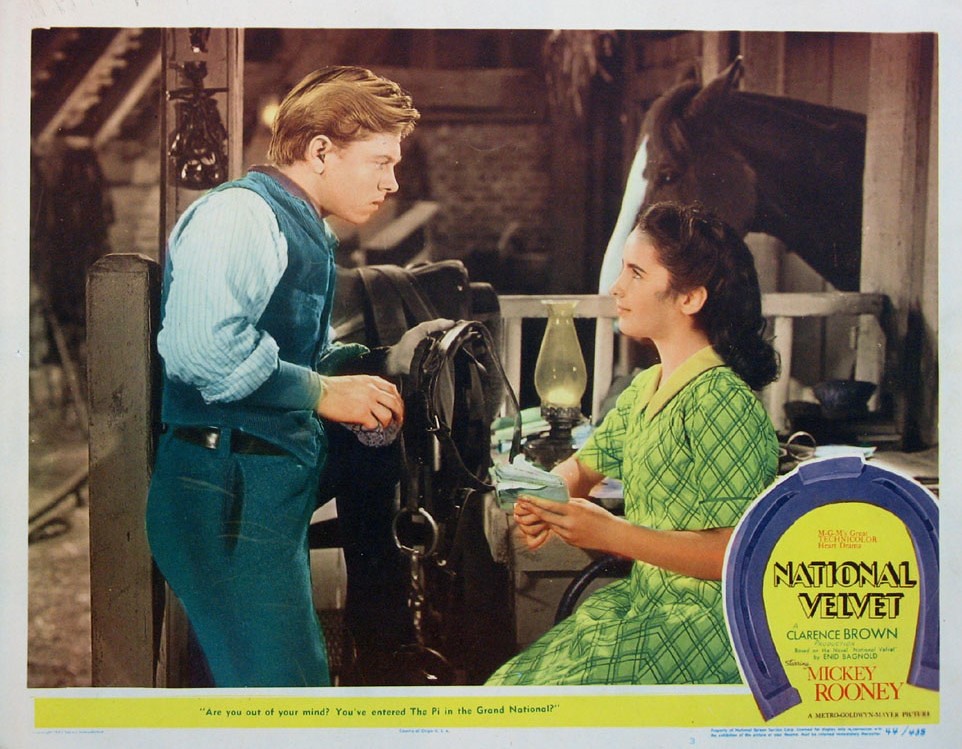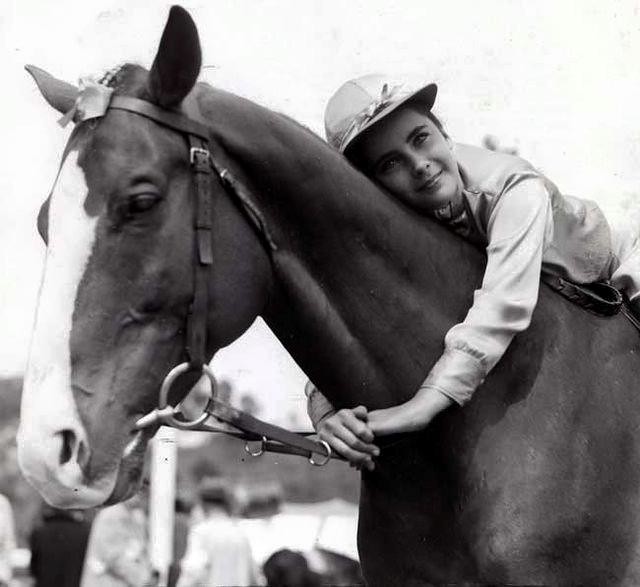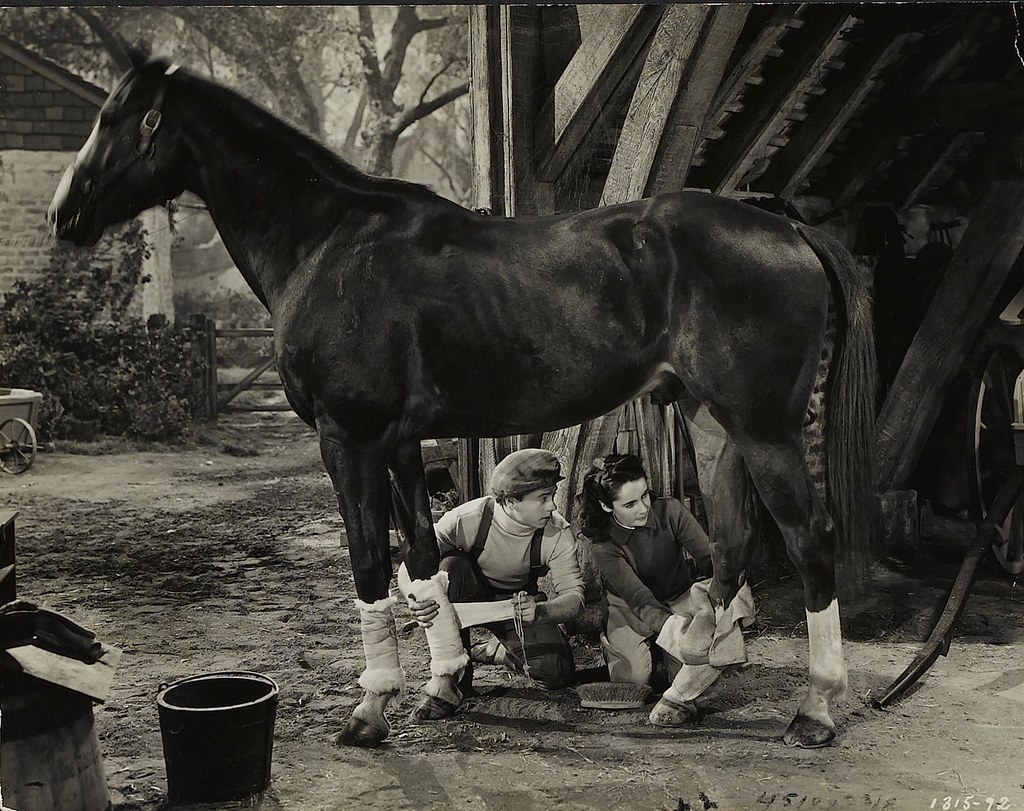WHAT: National Velvet (1944, DCP)
WHEN: November 16, 2022 1 PM & 7:30 PM
WHERE: Pickwick Theatre, Park Ridge, IL
WHAT ELSE: Organist Jay Warren performs pre-show music at 7 PM!
HOW MUCH: $12/$10 advance or $10 for the 1 PM matinee
Advance tickets: Click Here!
Revisiting National Velvet
by Mary Dalton
I’m always a little surprised when people tell me that they’ve never seen National Velvet, a film that’s right up there with Lassie Come Home and The Wizard of Oz in terms of family-friendly classics of the Golden Age.
The film starred 12-year-old Elizabeth Taylor – more ethereal and radiant than she would ever again be – to play Velvet Brown, a girl who disguises herself as a man in order to ride in England’s Grand National steeplechase. This was long before Hollywood started making Girl Power movies, and in my mind they did them better back in 1944.
National Velvet inspired several generations of horse-crazy kids – including me – to take up riding. (I even wanted to be a jockey for a time, and ended up galloping racehorses as a teen, but that’s a tale for another time.) It has what is arguably the most thrilling racing sequence in movies, next to the chariot race in Ben-Hur.
The story suggests that anyone with a dream for glory should go for it – yet it also has something to say about the nature of ambition. “Having dreams” is an idea that’s played out endlessly in our culture, and not always in a healthy way. We often think that rising to the top means staying there, at all costs, and for maximum gain. This movie argues differently.
At its heart, though, National Velvet is a story about human relationships, especially those in families. It shows both the good and the bad, the quiet movements and sudden storms that characterize family life. As the years have passed I’ve found myself appreciating National Velvet more than ever, especially at a time when family life has become so fractured, and we struggle to understand where we’ve come to in our culture.
It’s hardly a new struggle, of course. When Enid Bagnold’s novel National Velvet appeared back in 1935, the world was in the midst of a depression, and fascism was taking hold in Europe. She’d placed the novel’s action somewhere in the late 1920s, but the film version was set about 10 years later, to put more emphasis on the economic woes of the era.
This helped define Mickey Rooney’s crucial role as Mi Taylor, a penniless young drifter who becomes Velvet’s friend and trainer. Rooney had come fresh off one of his last Andy Hardy movies to make National Velvet, and the U.S. Army had given the studio only one month to shoot all his scenes before he was sent overseas. The fact that he was still able to turn in such a fine performance is a credit to his versatile talent.
His Mi is a shady, rootless character, standing in contrast to the tight-knit Brown family. Anne Revere plays Mrs. Araminty Brown, with Donald Crisp as her husband, Herbert. Their children include Edwina (a teenaged Angela Lansbury), Malvolia, and Velvet, as well as a young boy named Donald. Much of the story is driven by how Mi interacts with these characters as individuals.
Even though she’s a middle child in a noisy family, Velvet stands out. She enjoys a special relationship with her mother, despite the fact that they often seem at opposite ends of the emotional spectrum. Velvet is dreamy and impetuous, while Mrs. Brown is taciturn and grounded. Yet the two have far more in common than meets the eye.
Gene Tierney had been MGM’s first choice to play Velvet, but it’s hard now to imagine anyone other than Taylor in the role. In addition to being charismatic onscreen, Taylor was a natural rider and did many of her own stunts (although she suffered an accident while filming that left her with life-long spinal issues).
Because she was so young, the studio delayed production in order to give her a chance to grow taller. Taylor later told her biographer that she literally willed herself to gain several more inches. She would bring that intense determination to her performance.
It’s worth giving a special mention to Anne Revere as Mrs. Brown. The actress won an Academy Award for her supporting role, and it was well-deserved, for she dominates almost every scene she’s in. In the novel, Mrs. Brown is a huge, reserved woman, who doesn’t speak unless she needs to. Without being fat, Revere gives her character something of that gravitas, and makes her the moral center of the story.
She also presents a character you almost never find in films these days: a mother who is her daughter’s hero. Although I wouldn’t go so far as to say that this is a female-dominated story (Mi and Mr. Brown have important roles, too), one has to appreciate a movie that shows a mother as such a positive figure, rather than making her an obstacle to her child’s success or killing her off (as Disney films are wont to do).
One can also appreciate how well the story shows men and women supporting each other, without hitting you over the head with messaging. They do it in traditional ways, yes, but there’s a lot of unconventional moments, too.
The film opens with Velvet meeting Mi on the road to their village. He’s heading there to meet Velvet’s mother, whose name he found in his dead father’s address book. Mi hopes to exploit the connection for whatever he might get from it, even though he has no idea who she really is.
In fact, Mrs. Brown was once a celebrity: years earlier, she’d been the first woman to swim the English Channel. Now she lives in deliberate obscurity, raising her family and helping her husband run the butcher shop. Mi is the son of her former coach, Dan Taylor, but Mrs. Brown, who senses what Mi’s after, refuses to reveal the connection.
These early scenes are interesting in how they show Mi’s contradictions. He’s an opportunist but not comfortable in that role; one moment boyish and shy in the presence of Mrs. Brown, the next moment coldly planning to steal the family’s money. When Velvet tells him that she’s convinced her father to give him a job, Mi accepts, at least in the short-term. He’s slightly annoyed by Velvet helping him, because he knows he doesn’t deserve it.
Velvet likes Mi because he seems to be an expert on her favorite thing in the world: horses. When he tells her that he hates the animals, she refuses to believe it. She’s convinced that they’re kindred spirits. At one point, she speaks so rapturously about horses that Mi puts his hand on her forehead to check if she’s feverish.
“I want to be a famous rider,” she tells him. “I should like to hunt. Ride to hounds. I should like to race. I should like so many horses, that I can walk between the loose boxes and ride whom I choose.”
Taylor’s gorgeous, preternaturally mature face lights up in that moment, as if she were a woman in love. Psychologists have suggested all kinds of theories as to why adolescent girls are so passionate about horses. One is that riding a horse offers a sense of power, allowing a girl to become a part of something faster and stronger than herself.
Watching Taylor onscreen as Velvet, galloping across the fields on horseback, one feels that those psychologists might be on to something. Velvet wins The Pie in a raffle after the horse’s owner decides that he’s untrainable, and contrives to get rid of him by selling tickets for a shilling. But the girl senses greatness in The Pie, and wants to prove that he’s more than he seems.
This movie is full of parallel themes, and in less capable hands it might have been a sentimental mess. Mi and The Pie are both in need of some kind of redemption. To give her horse his moment of glory, Velvet needs Mi’s help, because it turns out he was once a jockey, and knows what it takes to win the big race. Mi himself needs to find a sense of purpose beyond being a bum.
At the same time, it’s Mrs. Brown who makes Velvet’s Grand National dream possible, when she uses the gold sovereigns that were her prize money to fund the entry fee for the race. Mrs. Brown speaks of her daughter’s dream as “a bit of folly,” suggesting that dreams may sometimes be foolish or transitory. Still, they’re worth pursuing, if approached the right way.
“Win or lose, it’s all the same,” Mrs. Brown says. “It’s how you take it that counts . . . things come suitable to the time, Velvet. Enjoy each thing, then forget it and go on to the next. There’s a time for everything. There’s a time for having a horse in the Grand National. Being in love, having children. Yes, even for dying. All in proper order at the proper time.”
This is a marvelous scene, and while some may think that Mrs. Brown is saying that her best days are behind her, I don’t believe that’s how she means it. For years she’s been waiting for the right moment to use her prize money. Now she’ll use it to help her child pursue her own dream, no matter what the result may be.
Mrs. Brown’s words will be echoed again after the race, when Velvet becomes a celebrity and has to face all the temptations of fame. As I mentioned before, National Velvet has a lot to say about conquering obstacles, but it’s told from a mid-century perspective.
At this point no one is suggesting that Velvet herself will ride the race. Women weren’t allowed to ride in the Grand National until 1977, in part because of opposition from male riders, but also because the race is particularly grueling: over four miles long, with 30 massive jumps.
Velvet’s not interested in shattering glass ceilings. Her only goal is to give her horse his big opportunity. Her faith in him has an almost divine quality. When she meets their hired jockey the night before the race and realizes that he doubts The Pie’s chances, she impulsively fires him, much to Mi’s consternation.
Yet here’s where the story makes a significant shift. Mi resists Velvet’s initial suggestion that he become the rider, confessing that he’d left racing years earlier after causing a fatal accident. On his own, however, he realizes he wants a chance to redeem himself, and decides to ride.
When he talks to Velvet, however, he learns that now she wants to be the rider. I love how Mi struggles with his feelings in this scene, because it shows how far he’s come in his own journey.
“So now it’s the glory of winning you want for yourself, is that it?” he asks her. “You want to ride your race, take your risks, and win. You want to win over them all, in sight of the world. Velvet Brown, before the King and Queen . . . ”
Mi gives in to her, because he knows this is Velvet’s moment, and his will have to come later. It’s a neat bit of synchronicity that he will unknowingly become for Velvet what his father was for her mother: her champion and ally, giving her the courage to face the ultimate challenge.
Did I mention that National Velvet has a fantastic Grand National sequence? We get hints of it in the scenes where Velvet and Mi are training The Pie, but up until that point there’s been so much human drama that viewers are almost unprepared for the reality of the race itself.
The film won its second Oscar for film editing and one can see why, especially when you get to watch the action on a big screen. We get closeups of horses thundering down the stretch and flying over fences, jostling for position in tight packs, taking tumbles and losing their riders – and one understands why the Grand National is considered one of the most dangerous horse races in the world.
After the race, there’s an unexpected – but utterly satisfying – final act in the story. I won’t say anything more, because I want you to see the movie and enjoy it for yourself.
National Velvet was a huge hit when it came out and deserves to be rediscovered by a new generation. Just as wartime audiences found hope in its portrayal of the love, courage, and self-sacrifice, we can watch the movie and appreciate how it celebrates family life, and the need we all have for dreams, especially now.
But be warned, parents. Your kids might be begging for riding lessons after seeing National Velvet, and you never know where that’s going to go.
Mary Dalton is an author and teacher who grew up in Park Ridge. She previously worked in public relations for the Park Ridge Public Library and has often contributed behind-the-scenes to the Pickwick Theatre Classic Film Series.
